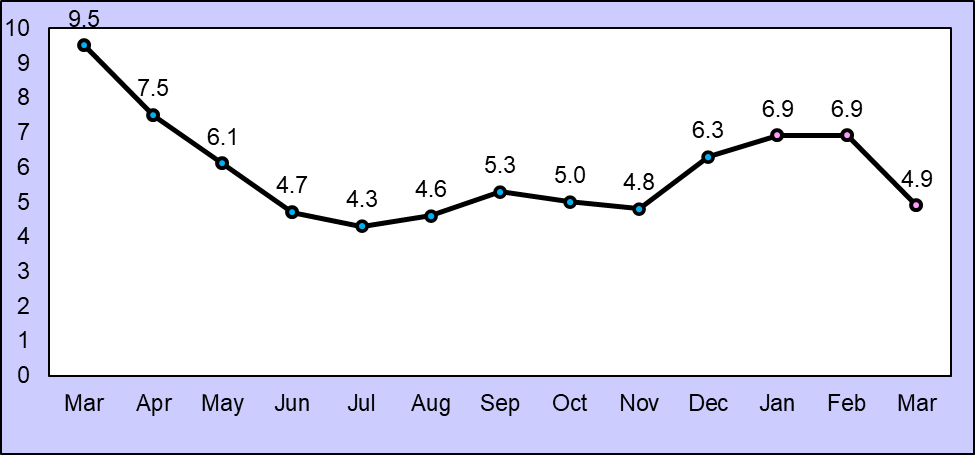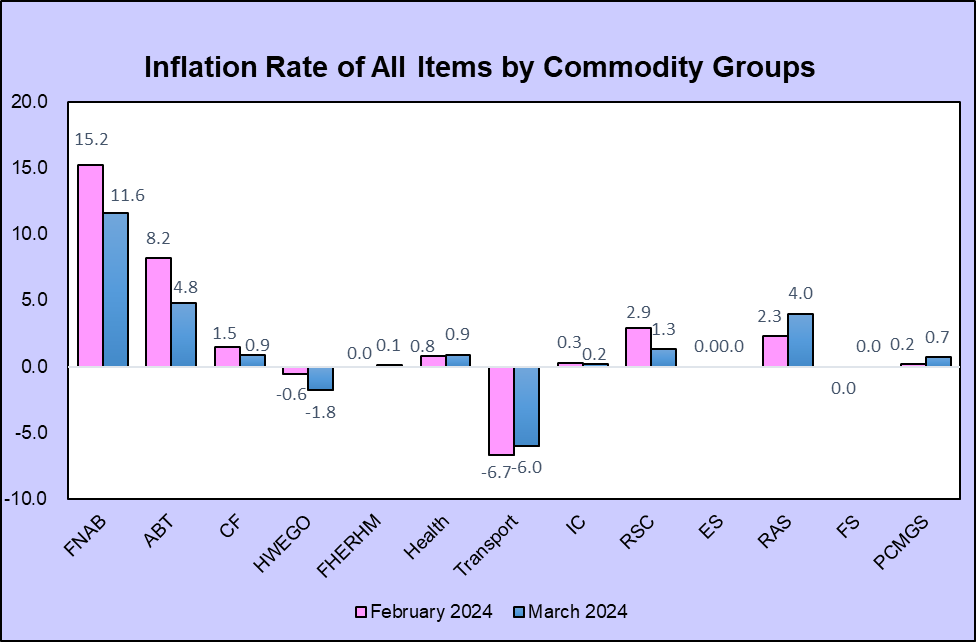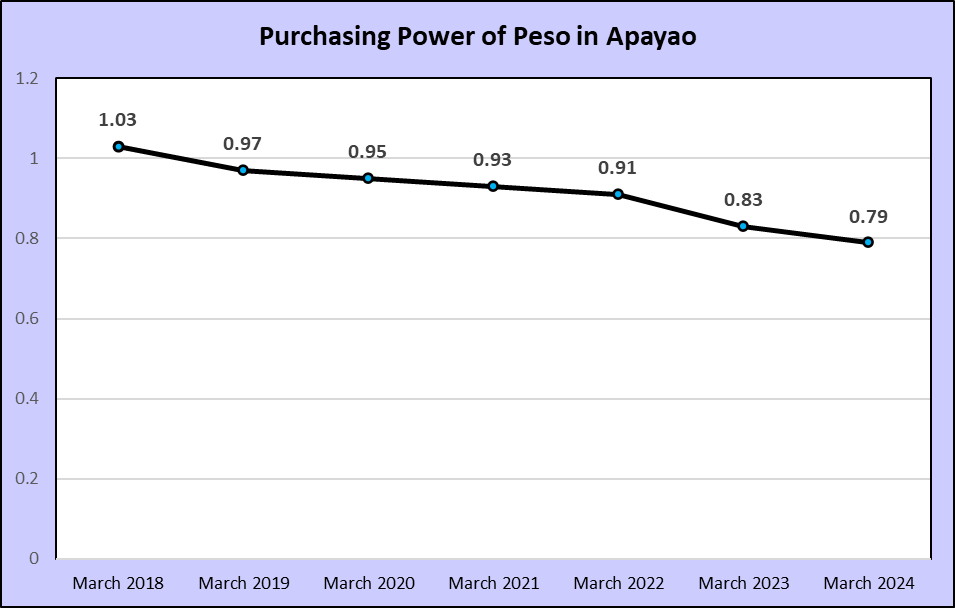Inflation Rate decelerated to 4.9 percent in March 2024
Table 1. Year-on-Year Inflation Rates in Apayao Province, All Items in Percent March 2024 (2018=100)
March 2023 | February 2024 | March 2024 | Year-to-date |
9.5 | 6.9 | 4.9 | 6.2 |
Source: Retail Price Survey of Commodities for the Generation of Consumer Price Index, Philippine Statistics Authority
The province’s inflation rate decelerated to 4.9 percent in March 2024 from 6.9 percent in February 2024. It is lower by 4.6 percentage points compared with the same month of the previous year at 9.5 percent and 2.0 percentage points lower than February 2024 at 6.9 percent. (Figure 1 and Table 1)
Figure 1. Year-on Year Inflation Rate, All Items in Percent, March 2023 – March 2024 (2018=100)

Source: Retail Price Survey of Commodities for the Generation of Consumer Price Index, Philippine Statistics Authority
Table 2. Year-on-Year Consumer Price Index in Apayao, By Commodity Groups in Percent (2018=100)
Commodity Groups | March 2023 | February 2024 | March 2024 |
ALL ITEMS | 120.9 | 129.0 | 126.8 |
I. Food and Non-Alcoholic Beverages | 114.9 | 132.4 | 128.2 |
II. Alcoholic Beverages and Tobacco | 150.8 | 161.5 | 158.0 |
III. Clothing and Footwear | 119.9 | 121.0 | 121.0 |
IV. Housing, Water, Electricity, Gas and Other Fuels | 129.0 | 127.0 | 126.7 |
V. Housing, Water, Electricity, Gas and Other Fuels | 115.3 | 115.3 | 115.4 |
VI. Health | 113.7 | 114.6 | 114.7 |
VII. Transport | 140.9 | 131.9 | 132.4 |
VIII. Information and Communication | 103.3 | 103.4 | 103.5 |
IX. Recreation, Sport and Culture | 133.9 | 135.9 | 135.7 |
X. Education Services | 109.4 | 109.4 | 109.4 |
XI. Restaurants and Accommodation Services | 150.1 | 155.7 | 156.1 |
XII. Financial Services | 146.0 | 146.0 | 146.0 |
XIII. Personal Care, and Miscellaneous Goods and Services | 116.8 | 117.4 | 117.6 |
Source: Retail Price Survey of Commodities for the Generation of Consumer Price Index, Philippine Statistics Authority
The overall CPI increased from 120.9 of the same month of the previous year to 126.8 on March 2024, representing a 4.9% inflation rate. The data shows that the value of goods amounting 100 pesos in the base year 2018 values 120.90 pesos in March 2023; 129.00 pesos in February 2024; and 126.8 pesos in March 2024. When the CPI increases, it indicates that the average price level of goods and services has also increased, and vice versa.
Specifically, four (4) commodity groups decreased compared to the previous month’s CPI which are: 1) Food and Non-Alcoholic Beverages which decreased by -4.2; 2) Alcoholic Beverages and Tobacco by -3.5; 3) Housing, Water, Electricity, Gas and Other Fuels by -0.3; and 4) Recreation, Sport and Culture by -0.2. (Table 2)
On the other hand, six (6) commodity groups increased on its CPI which are: 1) Transport by 0.5; 2) Restaurants and Accommodation services with 0.3; 3) Personal Care and Miscellaneous Goods and Services by 0.2; 4) Furnishing, Household Equipment and Routine Household Maintenance with 0.1; 5) Health with 0.1; and Information and Communication with 0.1. (Table 2)
Furthermore, Clothing and Footwear, Education Services, and Financial Services retained on their CPI. (Table 2)
Table 3. Year-on-Year Inflation Rates in Apayao, By Commodity Groups in Percent (2018=100)
Commodity Groups | March 2023 | February 2024 | March 2024 |
ALL ITEMS | 9.5 | 6.9 | 4.9 |
I. Food and Non-Alcoholic Beverages | 9.5 | 15.2 | 11.6 |
II. Alcoholic Beverages and Tobacco | 5.8 | 8.2 | 4.8 |
III. Clothing and Footwear | 5.7 | 1.5 | 0.9 |
IV. Housing, Water, Electricity, Gas and Other Fuels | 10.1 | -0.6 | -1.8 |
V. Furnishing, Household Equipment and Routine Household Maintenance | 2.8 | 0.0 | 0.1 |
VI. Health | 0.8 | 0.8 | 0.9 |
VII. Transport | 20.5 | -6.7 | -6.0 |
VIII. Information and Communication | 1.1 | 0.3 | 0.2 |
IX. Recreation, Sport and Culture | 10.5 | 2.9 | 1.3 |
X. Education Services | 0.0 | 0.0 | 0.0 |
XI. Restaurants and Accommodation Services | 20.6 | 2.3 | 4.0 |
XII. Financial Services | 0.0 | 0.0 | 0.0 |
XIII. Personal Care, and Miscellaneous Goods and Services | 3.9 | 0.2 | 0.7 |
Source: Retail Price Survey of Commodities for the Generation of Consumer Price Index, Philippine Statistics Authority
The commodity groups which had the highest percentage share in the downtrend during the period are as follows:
Food and Non-Alcoholic Beverages, which accounted for 11.6 percent and had an 85.3 percent share in the overall trend;
Housing, Water, Electricity, Gas and Other Fuels, which accounted for -1.8 percent and had a 9.3 percent share in the overall trend;
Alcoholic Beverages and Tobacco, which accounted for 4.8 percent and had a 3.2 percent share in the overall trend;
Clothing and Footwear, which accounted for 0.9 percent and had a 1.5 percent share in the overall trend;
Recreation, Sport, and Culture, which accounted for 1.3 percent and had a 0.6 percent share in the overall trend;
Information and Communication, which accounted for 0.2 percent and had a 0.1 percent share in the overall trend. (Figure 2 and Table 3)
Moreover, the following commodity sub-class which has the highest percent share in the inflation trend during the month of March 2024 are:
Rice with 67.7 percent;
Eggs of hen and other birds in shell, fresh with 7.8 percent;
Liquefied hydrocarbons (butane, propane, etc.) delivered in storage containers with 4.1 percent;
Electricity from all sources (coal, solar, hydro, etc.) with 3.9 percent;
Bananas, fresh with 1.5 percent;
Other pelagic fish, live, fresh, chilled or frozen with 1.3 percent;
Fuel wood, in logs, in billets, in twigs, in faggots or in similar forms with 1.3 percent;
Mangoes, guavas and mangosteens, fresh with 1.2 percent;
Cigarettes with 1.1 percent;
Other fish, dried, salted, in brine, smoked with 1.0 percent;
Other vegetable-based tobacco products with 0.9 percent;
Footwear for men including sportswear with 0.8 percent;
Powdered milk with 0.7 percent;
Coffee with 0.7 percent;
Garlic, fresh or chilled with 0.5 percent;
Coconut oil with 0.5 percent;
Cane sugar with 0.5 percent;
Footwear for women including sports footwear with 0.4 percent;
Footwear for children (2-17 years old) with 0.3 percent;
Tomatoes, fresh or chilled with 0.3 percent;
Freshwater fish, live, fresh, chilled or frozen with 0.3 percent;
Traditional games with 0.3 percent;
Water with 0.3 percent;
Other egg products with 0.2 percent;
Toys of all kinds with 0.2 percent;
Other tobacco products with 0.2 percent;
Drawing and painting materials with 0.2 percent;
Prepaid subscription with 0.1 percent;
Soft drinks with 0.1 percent;
Fruits and vegetables juices with 0.1 percent;
Onions and shallots, fresh or chilled with 0.1 percent;
Ice, ice cream and sorbet with 0.1 percent;
Coconuts, fresh with 0.1 percent; and
Concentrates and ready to drink juice with 0.1 percent
On the contrary, the remaining commodity groups with no contribution in the trend are Education Services and Financial Services at 0.0 inflation rate. (Figure 2 and Table 3)
Figure 2. Inflation Rate of All Items by Commodity Groups, Comparison Between February 2024 and March 2024

Source: Retail Price Survey of Commodities for the Generation of Consumer Price Index, Philippine Statistics Authority
Purchasing Power of Peso (PPP) recorded at 0.79 in March 2024
Purchasing power of peso continues to weaken through the years and reached 0.79 in March 2024. The PPP of 0.79 implies that the Php1.00 in the base year 2018 values only Php 0.79 in March 2024. A high purchasing power of the peso indicates that the currency can purchase a greater quantity of goods and services. Conversely, a low purchasing power signifies that the currency has depreciated in value and can acquire a reduced amount of goods and services. (Figure 3)
Figure 3. Purchasing Power of Peso in Apayao (2018=100): March 2018 – March 2024

Source: Retail Price Survey of Commodities for the Generation of Consumer Price Index, Philippine Statistics Authority
DEFINITION OF TERMS
Consumer Price Index (CPI) measures the overall change in consumer prices based on a representative basket of goods and services over time.
Inflation refers to an overall increase in the Consumer Price Index (CPI), which is a weighted average of prices for different goods.
Purchasing power of the peso shows how much the peso in the base period is worth in the current period. It is computed as the reciprocal of the CPI for the period under review multiplied by 100.
Commodity Groups are group of goods and services found in the market basket of the province. There are thirteen (13) commodity groups which were arranged according to the PCOICOP.
PCOICOPa detailed classification of individual consumption expenditures on goods and services incurred by the three of the five (5) institutional sectors of the 1993 and 2008 System of National Accounts (SNA), namely: (a) households, (b) financial corporations, (c) non-financial corporations, (d) general government, and (e) non-profit institutions serving households. It stands for Philippine Classification of individual Consumption According to Purpose.
FNAB stands for Food and Non-Alcoholic Beverages
ABT stands for Alcoholic Beverages and Tobacco
CF stands for Clothing and Footwear
HWEGO stands for Housing, Water, Electricity, Gas, and Other Fuels
FHERHM stands for Furnishings, Household Equipment and Routine Household Maintenance
IC stands for Information and Communication
RSC stands for Recreation, Sport, and Culture
ES stands for Education Services
RAS stands for Restaurants and Accommodation Services
FS stands for Financial Services
PCMGS stands for Personal Care, Miscellaneous Goods and Services
Approved by:
GEOFFREY B. CALIMUHAYAN
Chief Statistical Specialist
LSBT

